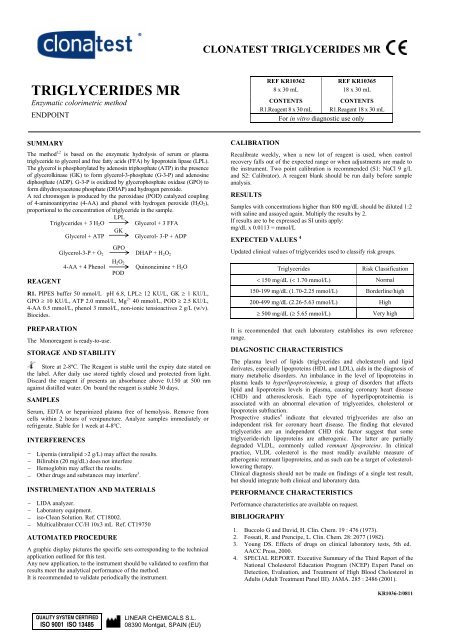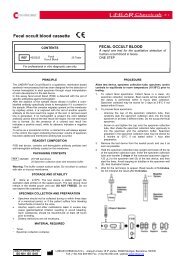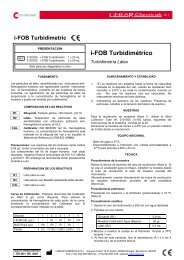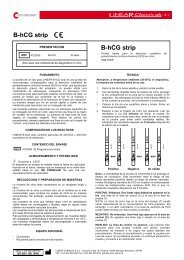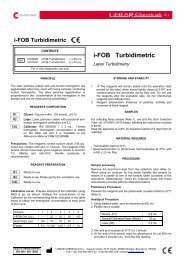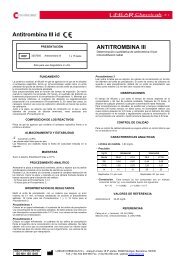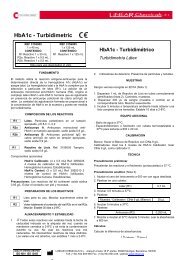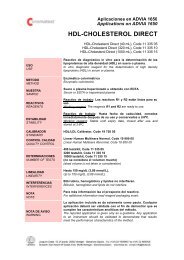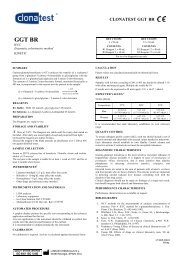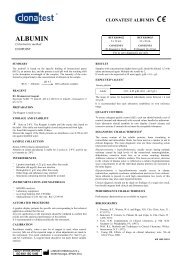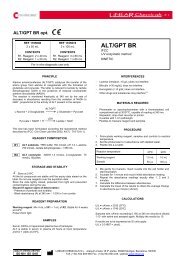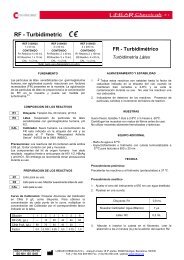TRIGLYCERIDES MR - LINEAR CHEMICALS
TRIGLYCERIDES MR - LINEAR CHEMICALS
TRIGLYCERIDES MR - LINEAR CHEMICALS
Create successful ePaper yourself
Turn your PDF publications into a flip-book with our unique Google optimized e-Paper software.
CLONATEST <strong>TRIGLYCERIDES</strong> <strong>MR</strong><strong>TRIGLYCERIDES</strong> <strong>MR</strong>Enzymatic colorimetric methodENDPOINTREF KR10362REF KR103658 x 30 mL 18 x 30 mLCONTENTSCONTENTSR1.Reagent 8 x 30 mL R1.Reagent 18 x 30 mLFor in vitro diagnostic use onlySUMMARYThe method 1,2 is based on the enzymatic hydrolysis of serum or plasmatriglyceride to glycerol and free fatty acids (FFA) by lipoprotein lipase (LPL).The glycerol is phosphorylated by adenosin triphosphate (ATP) in the presenceof glycerolkinase (GK) to form glycerol-3-phosphate (G-3-P) and adenosinediphosphate (ADP). G-3-P is oxidized by glycerophosphate oxidase (GPO) toform dihydroxyacetone phosphate (DHAP) and hydrogen peroxide.A red chromogen is produced by the peroxidase (POD) catalyzed couplingof 4-aminoantipyrine (4-AA) and phenol with hydrogen peroxide (H 2 O 2 ),proportional to the concentration of triglyceride in the sample.LPLTriglycerides + 3 H 2 OGlycerol + 3 FFAGKGlycerol + ATPGlycerol- 3-P + ADPGPOGlycerol-3-P + O 2 DHAP + H 2 O 2H 2 O 24-AA + 4 PhenolQuinoneimine + H 2 OPODREAGENTR1. PIPES buffer 50 mmol/L pH 6.8, LPL≥ 12 KU/L, GK ≥ 1 KU/L,GPO ≥ 10 KU/L, ATP 2.0 mmol/L, Mg 2+ 40 mmol/L, POD ≥ 2.5 KU/L,4-AA 0.5 mmol/L, phenol 3 mmol/L, non-ionic tensioactives 2 g/L (w/v).Biocides.PREPARATIONThe Monoreagent is ready-to-use.STORAGE AND STABILITYStore at 2-8ºC. The Reagent is stable until the expiry date stated onthe label. After daily use stored tightly closed and protected from light.Discard the reagent if presents an absorbance above 0.150 at 500 nmagainst distilled water. On board the reagent is stable 30 days.SAMPLESSerum, EDTA or heparinized plasma free of hemolysis. Remove fromcells within 2 hours of venipuncture. Analyze samples immediately orrefrigerate. Stable for 1 week at 4-8ºC.INTERFERENCES−−−−Lipemia (intralipid >2 g/L) may affect the results.Bilirubin (20 mg/dL) does not interfereHemoglobin may affect the results.Other drugs and substances may interfere 3 .INSTRUMENTATION AND MATERIALS−−−−LIDA analyzer.Laboratory equipment.iso-Clean Solution. Ref. CT18002.Multicalibrator CC/H 10x3 mL Ref. CT19750AUTOMATED PROCEDUREA graphic display pictures the specific sets corresponding to the technicalapplication outlined for this test.Any new application, to the instrument should be validated to confirm thatresults meet the analytical performance of the method.It is recommended to validate periodically the instrument.CALIBRATIONRecalibrate weekly, when a new lot of reagent is used, when controlrecovery falls out of the expected range or when adjustments are made tothe instrument. Two point calibration is recommended (S1: NaCl 9 g/Land S2: Calibrator). A reagent blank should be run daily before sampleanalysis.RESULTSSamples with concentrations higher than 800 mg/dL should be diluted 1:2with saline and assayed again. Multiply the results by 2.If results are to be expressed as SI units apply:mg/dL x 0.0113 = mmol/LEXPECTED VALUES 4Updated clinical values of triglycerides used to classify risk groups.TriglyceridesRisk Classification< 150 mg/dL (< 1.70 mmol/L) Normal150-199 mg/dL (1.70-2.25 mmol/L) Borderline/high200-499 mg/dL (2.26-5.63 mmol/L) High≥ 500 mg/dL (≥ 5.65 mmol/L)Very highIt is recommended that each laboratory establishes its own referencerange.DIAGNOSTIC CHARACTERISTICSThe plasma level of lipids (triglycerides and cholesterol) and lipidderivates, especially lipoproteins (HDL and LDL), aids in the diagnosis ofmany metabolic disorders. An imbalance in the level of lipoproteins inplasma leads to hyperlipoproteinemia, a group of disorders that affectslipid and lipoproteins levels in plasma, causing coronary heart disease(CHD) and atherosclerosis. Each type of hyperlipoproteinemia isassociated with an abnormal elevation of triglycerides, cholesterol orlipoprotein subfraction.Prospective studies 4 indicate that elevated triglycerides are also anindependent risk for coronary heart disease. The finding that elevatedtriglycerides are an independent CHD risk factor suggest that sometriglyceride-rich lipoproteins are atherogenic. The latter are partiallydegraded VLDL, commonly called remnant lipoproteins. In clinicalpractice, VLDL colesterol is the most readily available measure ofatherogenic remnant lipoproteins, and as such can be a target of colesterolloweringtherapy.Clinical diagnosis should not be made on findings of a single test result,but should integrate both clinical and laboratory data.PERFORMANCE CHARACTERISTICSPerformance characteristics are available on request.BIBLIOGRAPHY1.2.3.4.Buccolo G and David, H. Clin. Chem. 19 : 476 (1973).Fossati, R. and Prencipe, L. Clin. Chem. 28: 2077 (1982).Young DS. Effects of drugs on clinical laboratory tests, 5th ed.AACC Press, 2000.SPECIAL REPORT. Executive Summary of the Third Report of theNational Cholesterol Education Program (NCEP) Expert Panel onDetection, Evaluation, and Treatment of High Blood Cholesterol inAdults (Adult Treatment Panel III). JAMA. 285 : 2486 (2001).KR1036-2/0811QUALITY SYSTEM CERTIFIEDISO 9001 ISO 13485<strong>LINEAR</strong> <strong>CHEMICALS</strong> S.L.08390 Montgat, SPAIN (EU)
CLONATEST <strong>TRIGLYCERIDES</strong> <strong>MR</strong>TRIGLYCERIDOS <strong>MR</strong>Método enzimático colorimétricoPUNTO FINALREF KR10362REF KR103658 x 30 mL 18 x 30 mLCONTENIDOCONTENIDOR1.Reactivo 8 x 30 mL R1.Reactivo 18 x 30 mLSólo para uso diagnóstico in vitroFUNDAMENTOEl método 1,2 está basado en la hidrólisis enzimática de los triglicéridosséricos a glicerol y ácidos grasos libres (FFA) por acción de la lipoproteinlipasa (LPL). El glicerol es fosforilado por el adenosin trifosfato (ATP) enpresencia de glicerolquinasa (GK) para formar glicerol-3-fosfato (G-3-P)y adenosin difosfato (ADP). El G-3-P es oxidado por la glicerofosfatooxidasa (GPO) en dihidroxiacetona fosfato (DHAP) y peróxido dehidrógeno. En presencia de peroxidasa (POD) el fenol y la 4-aminoantipirina (4-AA) se condensan por acción del peróxido dehidrógeno (H 2 O 2 ) formándose un cromógeno rojo proporcional a laconcentración de triglicéridos presentes en la muestra.LPLTriglicéridos + 3 H 2 OGlicerol + 3 FFAGlicerol + ATPGKGlicerol- 3-P + ADPGPOGlicerol-3-P + O 2 DHAP + H 2 O 2H 2 O 24-AA + 4 FenolQuinonaimina + H 2 OPODREACTIVOR1. Tampón PIPES 50 mmol/L pH 6,8, LPL≥ 12 KU/L, GK ≥ 1 KU/L,GPO ≥ 10 KU/L, ATP 2,0 mmol/L, Mg 2+ 40 mmol/L, POD ≥ 2,5 KU/L,4-AA 0,5 mmol/L, fenol 3 mmol/L, tensioactivos no-iónicos 2 g/L (p/v).Biocidas.PREPARACIONEl Monoreactivo está listo para su uso.ALMACENAMIENTO Y ESTABILIDADConservar a 2-8ºC. El Reactivo es estable hasta la fecha decaducidad indicada en la etiqueta. Desechar el reactivo cuando presenteuna absorbancia superior a 0,150 a 500 nm frente agua destilada. Despuésde su uso diario, mantener bien cerrado y protegido de la luz. En elanalizador es estable 30 días.MUESTRASSuero, plasma heparinizado u obtenido con EDTA libre de hemólisis. Separarlas células dentro de las 2 horas siguientes a la venipuntura. Analizar lasmuestras de inmediato o refrigerarlas. Estables 1 semana a 4-8ºC.INTERFERENCIAS−−−−Lipemia (intralipid >2 g/L) puede afectar los resultados.Bilirrubina (20 mg/dL) no interfiere.Hemoglobina puede afectar los resultados.Otros medicamentos y sustancias pueden interferir 3 .EQUIPO ADICIONAL−−−−Analizador KROMA.Material de laboratorio.iso-Clean Solution. Ref. CT18002.Multicalibrator CC/H 10x3 mL Ref. CT19750TECNICA AUTOMATICAUna representación grafica visualiza los ajustes específicoscorrespondientes a la aplicación técnica diseñada para este ensayo.Cualquier aplicación nueva al instrumento deberá validarse paraconfirmar que los resultados cumplen las características del método.Se recomienda validar periódicamente el instrumento.CALIBRACIONRecalibrar semanalmente, al cambiar el lote de reactivos, cuando losvalores del control estén fuera del rango de aceptación o cuando serealicen ajustes en el instrumento. Se recomienda la Calibración de dospuntos (M1: ClNa 9 g/L y M2: Calibrador). Realizar un blanco delreactivo cada día de trabajo antes de analizar las muestras.CALCULOSMuestras con concentraciones superiores a 800 mg/dL deben diluirse 1:2con solución salina y repetir el ensayo. Multiplicar los resultados por 2.Para expresar los resultados en unidades SI aplicar:mg/dL x 0,0113 = mmol/LVALORES DE REFERENCIA 4Valores clínicos actualizados de triglicéridos empleados para clasificar losgrupos de riesgo.TriglicéridosClasificación< 150 mg/dL (< 1,70 mmol/L) Normal150-199 mg/dL (1,70-2,25 mmol/L) Medio/Alto200-499 mg/dL (2,26-5,63 mmol/L) Alto≥ 500 mg/dL (≥ 5,65 mmol/L)Muy altoSe recomienda que cada laboratorio establezca su propio rango dereferencia.CONTROL DE CALIDADPara un control de calidad (CC) adecuado, se incluirán en cada serie controlesvalorados (normal y abnormal) que se tratarán como muestras problema.Cada laboratorio debe establecer su propio Control de Calidad y sus medidascorrectoras cuando los controles no cumplan con las tolerancias exigidas.SIGNIFICADO CLINICOUn desequilibrio en el nivel de lipoproteínas plasmáticas conduce a unahiperlipoproteinemia, un grupo de trastornos que afectan a lípidos ylipoproteínas causantes de la enfermedad cardíaca coronaria y de laarterioesclerosis. Cada tipo de hiperlipoproteinemia está asociada con unaelevación anormal de triglicéridos, colesterol o de subfraccioneslipoproteicas. Estudios en curso 4 indican que la tasa de triglicéridos por simisma es también un factor de riesgo independiente de la enfermedadcardíaca coronaria. El hallazgo que unos triglicéridos elevados sean unfactor de riesgo independiente sugiere que algunas lipoproteínas ricas entriglicéridos son aterogénicas.El diagnóstico clínico no debe realizarse únicamente con los resultados deun único ensayo, sino que debe considerarse al mismo tiempo los datosclínicos del paciente.CARACTERISTICAS ANALITICASLas características analíticas están disponibles bajo solicitud.REFERENCIAS1.2.3.4.Buccolo G y David, H. Clin. Chem. 19 : 476 (1973).Fossati, R. y Prencipe, L. Clin. Chem. 28: 2077 (1982).Young DS. Effects of drugs on clinical laboratory tests, 5th ed.AACC Press, 2000.SPECIAL REPORT. Executive Summary of the Third Report of theNational Cholesterol Education Program (NCEP) Expert Panel onDetection, Evaluation, and Treatment of High Blood Cholesterol inAdults (Adult Treatment Panel III). JAMA. 285 : 2486 (2001).QUALITY SYSTEM CERTIFIEDISO 9001 ISO 13485<strong>LINEAR</strong> <strong>CHEMICALS</strong> S.L.08390 Montgat, SPAIN (EU)
Aplicaciones en KROMAApplications on KROMA<strong>TRIGLYCERIDES</strong> <strong>MR</strong>One reagent methodTriglycerides <strong>MR</strong> (8 x 30 mL), Code KR10362Triglycerides <strong>MR</strong> (18 x 30 mL), Code KR10365USOUSEMETODOMETHODMUESTRASAMPLEREACTIVOSREAGENTSCALIBRADORSTANDARDCONTROL CALIDADQUALITY CONTROLDETERMINACIONESNUMBER OF TESTSLINEALIDAD<strong>LINEAR</strong>ITYNOTANOTENOTA DE AVISOWARNINGReactivo de diagnóstico in vitro para la determinación detriglicéridos en suero o plasma.In vitro diagnostic reagent for the determination of triglycerides inserum or plasma.Enzimático colorimétrico.Enzymatic colorimétrico.Suero o plasma recogido en EDTA.Serum or EDTA plasma.El monoreactivo R1 esta listo para su uso.The monoreagent R1 is ready to use.Linear Multicalibrator CC/H, Code CT19750Linear Human Multisera Normal CT19800Linear Human Multisera Abnormal CT198501200 tests/kit, Code KR103622700 tests/kit, Code KR10365(no se considera el volumen muerto).(dead volume is not taken in consideration).Sin post-dilución automática: Hasta 800 mg/dLWithout automatic post-dilution: Up to 800 mg/dLPara más información lea el prospecto del reactivo.For additional information read reagent packaging insert.La aplicación incluida se da solamente como pauta. Cualquieraplicación deberá ser validada con el fin de demostrar que secumplen las características analíticas del método.The reported application is given only as a guideline. Any applicationto an instrument should be validated to demonstrate that results meetthe performance characteristics of the method.QUALITY SYSTEM CERTIFIEDISO 9001 ISO 13485<strong>LINEAR</strong> <strong>CHEMICALS</strong> S.L.08390 Montgat, SPAIN (EU)
KROMA<strong>TRIGLYCERIDES</strong> <strong>MR</strong>Name N. of Standards N. of rep. Units StabilityTriglycerides <strong>MR</strong> 2 1 mg/dL** entered by the user KR10362-65-1/0907QUALITY SYSTEM CERTIFIEDISO 9001 ISO 13485<strong>LINEAR</strong> <strong>CHEMICALS</strong> S.L.08390 Montgat, SPAIN (EU)


